SEPTEMBER 14, 2023



SEPTEMBER 14, 2023


The Nov. 7 election could make Ohio the next state to legalize marijuana. Issue 2 is the citizen-initiated statute that has the potential to make legalization happen.
The proposed law was written by the Coalition to Regulate Marijuana Like Alcohol. If enacted, the law will legalize the sale and use of marijuana for adults at least 21 years old and legalize homegrown plants.
Tom Haren, spokesperson for the coalition, said marijuana prohibition is a failed policy.
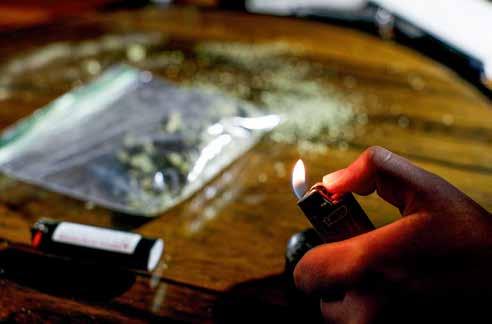
“Too many people – including too many young people, too many people of color – have their lives ruined by small marijuana convictions or run-ins with law enforcement,” Haren said. “It can make it harder to get a job, it can make it harder to get a loan or to qualify for financial aid, or to get into the college of your choice.”
While recreational use is illegal, Ohio has a medical marijuana program that is regulated under Ohio House Bill 523, which allows individuals with certain medical conditions to obtain the drug for medicinal use.
Access can be restricted for a variety of reasons, according to Haren, including federal restrictions, lack of dispensaries or having a condition that doesn’t qualify for the program.
“A large part of the reason why we're pursuing this is to ensure that clients who need access to cannabis to treat their pain or their chronic conditions have access that they don't currently have to our medical marijuana program,” Haren said.
The proposed law will collect 10% of sales tax on marijuana, which will be used to fund several initiatives; 36% of the
tax will go to social equity and job programs, another 36% will support the local dispensary’s community, 25% will go toward addiction treatment and education, and 3% is for the regulatory and administrative costs of the program.
If passed, sales can be made at licensed Ohio dispensaries. Athens, Ohio, currently has two dispensaries, Harvest of Athens and Debbie’s Dispensary, with another on the way, Big Perm’s.
“Medical marijuana sales in Ohio have been in effect for just over four years now with maybe 2% of Ohioans actually taking advantage of the Medical Marijuana Control Program. If Issue 2 passes, those numbers will be sure to increase, even with the stipulations and hurdles that some predict,” Harvest of Ohio Representative, Jeané Holley, wrote in an email.
Holley said eligible dispensaries will be able to receive an adult-use dispensary license within nine months after the law is passed to sell for recreational use.

“With the stigma of cannabis use fading, coupled with legalization, more individuals are using cannabis for their health and wellness needs – for relaxation, stress release, sleep improvement and chronic pain,” Holley wrote in an email. “With the passage of Issue 2, the number of individuals consuming marijuana in the legal market will steadily increase.”
Although Ohio would be legalizing marijuana, the substance is a Schedule 1 drug under the United States Drug Enforcement Administration’s Controlled Substance Act.
“Cannabis – as is heroin and LSD – are defined as (Schedule 1) drugs with no accepted medical use and have a high potential for abuse. In addition, the processing, sale and possession of cannabis remain illegal (under federal law), even for personal medical purposes. Even if legalized, individuals and businesses can potentially face penalties under federal law,” Holley wrote in an email.
Executive Director of the Drug Enforcement and Policy Center at Ohio State University Douglas Berman said the opening of more dispensaries around Ohio will create more job opportunities, including lawyers, accountants and security officials.
Berman said having a legal market also creates a safer and more regulated product.
“There's been a robust illicit market for decades, and what legalization does is ensure the consistency and the safety of the product, so that you don't have to worry about cannabis laced with pesticides, having heavy metals or having all sorts of other contaminants in it,” Berman said.
However, legalization doesn’t entirely erase the illicit market, especially when it comes to homegrown plants, Berman said. People may see Ohio as a place to illegally grow marijuana and then transport it to other states.
Even if Issue 2 is passed, the Ohio legislature has the power to overturn or alter the law, Holley said.
“Business leaders in Ohio’s cannabis market have been working on ballot measures for years. If it does not pass in 2023, they will not stop advocating and working to legalize recreational marijuana for Ohioans, age 21 and older,” Holley wrote in an email.
sides, including macaroni and cheese, waffle fries, fruit and cookies. The dining court also includes vegetarian wing options.
On the first day of classes, Aug. 28, a line of hungry underclassmen formed outside of Ohio University's newest dining option, Earl’s Coop, located at the corner of Shively Hall on East Green.
Before the creation of Earl’s Coop, Shively Hall was previously used for COVID-19 testing, but because the university is no longer mandating students to test or report symptoms, the testing location dissolved.
However, before Shively Hall was a COVID-19 testing location, it also was a dining hall, Shively Court. Shively Court closed in the spring of 2020 due to the low enrollment forecast for the Fall 2021 Semester, according to a previous Post report.
The closing of Shively Court left many students upset because it was taking away another dining hall option on campus.
“I really liked Shively as a freshman, and I think it was a really good option for East Green students,” Lauren Slanker, a first-year graduate student studying Counselor Education, said.
Despite rumors of Shively Court being up and running, Gwyn Scott, associate vice president for auxiliaries, said she does not anticipate the dining hall opening this fall.
Earl’s Coop is a Grab-N-Go dining option that serves fresh chicken strips with signature sauces, chicken sandwiches, and various

Students can use traditional or flex meal plans and they can pick out any sort of variation for a main dish and a side dish option. One meal swipe is equivalent to one meal –a main dish and a side dish. Those without meal plans can also use Bobcat Cash or a credit/debit card to purchase the food; an average meal costs $15.
The new dining court is open Monday through Thursday from noon to 10 p.m., Fridays from noon to 4 p.m. and closed on the weekends.
Earl’s Coop is the third traditional mealplan option, including Nelson Court, and The District on West Green. Smooth Moves, which is located in Boyd Market, also accepts traditional and flex meal plans for a smoothie combo.
There will be a grand opening held on Wednesday, Sept. 20 at noon, with a ribbon-cutting event, giveaways and Earl’s Coop samples, according to a university news statement.
Assistant Director for Residence Dining Autumn Ryder said since the opening of Earl’s Coop, she has received an overwhelming amount of positive feedback.
Alex Tamplin, a freshman studying aviation, said Earl’s Coop is the best food on campus.
“It’s pretty close to Cane’s,” Tamplin said.
September 14-28th
Sorority & Fraternity Life
September 11-15
Interfraternity Council Recruitment Week
For more information
visit the SFL office in Baker 330
September 18
PAWs for a Cause
(Hazing Prevention Speaker)
7:00 PM • Baker Ballroom
to view all events
“Nelson is nothing compared to this.”
Ryder said there was an inspiration behind Earl’s Coop to make it a similar option to other fast-food chain restaurants.
“When we describe to people what Earl’s (Coop) is, we kind of say it's a mix between Cane’s and Chick-fil-A, just the (OU) version,” Ryder said. “We’ve got a couple of different sauces on there that we purposely tried to –not mimic it – but make it similar.”
Dale Lindsey, general manager of Earl’s Coop and Shivley Grab ‘n’ Go, said business has been a lot busier than he anticipated it would be, but high business has left long lines leading outside the door of Earl’s Coop and circling around Shively Hall outside.
“We try to get people in and out as quick as we can,” Ryder said. “We’ve done some time studies that look at how quick people can go through. We tweaked some things;
we changed some things.”
Ryder said there will be an awning installed for students waiting in line outside. The awning was previously used for the Shively Grab ‘n’ Go, and she hopes it will be coming in within the next month. Ryder said the awning will also help during winter months, too.
Slanker said that having an additional dining meal option is crucial due to the rising number of enrollments.
“It’s actually super imperative to have that third dining option because of the amount of students we have now,” Slanker said. “And with my experience going to Nelson in the past couple of years, it’s just been too many people in one place.”
Athletics
September 16
Football vs. Iowa State
12:00 PM
September 14
Bobcat Bash
4:00 - 7:00 PM
South Beach
September 16
Paw Paw Festival
12:00 PM
First 15 Students get free tickets & transportation!
Meet at the LLC
September 14
UPC Stuff a Bobcat
6:00 - 8:00 PM
Baker Theatre Lounge
September 17
Pioneer Tournament
5:15 - 8:00 PM
Little Professor Book Center
September 22
Escape Rooms
7:30 - 9:30 PM
LLC 130-150
September 21
UPC Butterfly Garden
2:00 - 5:00 PM
Morton Field
September 21
Therapy Dog Thursday
3:30 - 5:00 PM
Alden Library 2nd Floor
September 23
Latin Night hosted by the Latinx Service Coalition
6:00 - 9:00 PM
Athena Cinema
September 26
Comedy Series featuring Janae Burris
7:00 - 8:00 PM
Baker Theater
September 27
Fall Career and Internship Fair
11:00 AM - 3:00 PM
Ping Recreation Center
September 28
UPC Giant Board Games
5:30 - 7:30 PM
Morton Field
* To have your event included on this calendar make sure it is registered on Bobcat Connect!
Peden Stadium
September 15
Field Hockey vs. Ball State
3:00 PM
Pruitt Field
September 21
Soccer vs. Kent State
4:00 PM
Chessa Field
September 22-23
Volleyball vs. Akron
22nd - 7:00 PM
23rd - 4:00 PM
Convocation Center
September 26
Volleyball vs. Kent State
7:00 PM
Convocation Center
Court Street welcomed a new restaurant this fall, Park’s Place, located at 5 N. Court St., occupying the space FRY’D, a former Athens french fry restaurant, vacated last year.
Park’s Place is a casual dining establishment that offers late-night to-go and sitdown meals. Its owner Josh Vernon, said he decided to expand the restaurant out of Amesville, which is also in Athens County, and open doors to Ohio University students and Athens residents.
The original restaurant in Amesville was founded in 2019 by Verson and his cousin Cory Richards who both grew up in Amesville. Now, Richards has recently moved on from Parks Place and doesn’t own either restaurant, ending the partnership that started three and a half years ago, Vernon said.
Park’s Place on Court Street is open from 11-3 a.m. on Fridays and Saturdays, and Monday through Thursday from 11 a.m. to 9 p.m.
“When the bars close at two, we’re here til three,” Vernon said. “We catch everyone on their way out.”
The menu consists of “sandos,” a fried chicken sandwich priced at $8 or $9, which is the most popular item, Vernon said. Sides include fried pickles, onion rings and cheese curds, ranging from $3 to $6. Many of the menu items are locally sourced, and vegetarian options are also available.
The menu on Court Street is nighttime-oriented, Vernon said, while the Amesville menu is more diverse, including brunch and breakfast options.
“(Parks Place is) more of a grab-and-go sandwich style and definitely targeted toward the late-night college crowd,” said Vernon.

On Fridays and Saturdays, it locks its doors at 9 p.m. and opens the front window, which is where customers order and pick up food. One person mans at the grill, another takes orders at the window and one person runs back and forth Ashley Merril, cook and front register worker, said.
Merrill said she loves working at Park’s Place and even has plans to work at the Amesville location as well.
Vernon said he and Richards wanted to revive an old building in Amesville with the original restaurant and that many people had tried doing that before but failed due to Amesville’s low population. Vernon said
Park’s Place decided to expand to Athens for its larger market and its close distance to Amesville.
“We knew that Court Street was the best place to do that in this area without expanding to a different county,” Vernon said. “Court Street was local enough that it was easy to manage but it also gave us access to a much larger audience.”
Restaurants on Court Street can turn over very quickly and Vernon said he hopes Park’s Place’s high-quality and locally sourced ingredients will make sure it maintains its spot uptown.
“We generally pride ourselves on higher-quality, locally sourced ingredients and
locally sourced food is much more sustainable,” Vernon said. “The higher-quality food will hopefully get people coming back time and time again.”
Vernon said he’s already noticed a few customers going to the restaurant every day since they opened.
Terrence Brown, an Athens resident, said when he went to the restaurant for the first time he was happy with the food.
“The food was good, it was tasty, well-seasoned, well-proportioned, fast,” Brown said. “The prices are real reasonable, the sandwich was $9.”
Brown had never been to the Amesville restaurant before, so this was his first time
trying the food. Brown said he would recommend people try it.
“We started out slow and it's been gaining and gaining ground each day,” Vernon said. “Late nights have been really good for us.”
Park’s Place is hiring and looking for a few more people to bring on board, Vernon said. They are also on Instagram and Facebook to promote the restaurant.
However, Willis also believes that while the party scene is an evident part of OU culture, people don’t only come to the school because of a hedonistic appeal.

“I know obviously that a lot of people party… but (there’s) more of a normal balance in a college life than I thought (there would be) from what I had heard or (from) OU’s reputation,” said Amiet.
Fiona Ferrari, a freshman studying psychology and health communications, doesn’t feel pressured to engage in the party scene if she doesn’t want to. Being an honors student, she recognizes that there are plenty of opportunities to have a social life and be involved with other OU students without attending parties.
“I knew that there (were) a lot of parties, but I also know that…I don’t have to go to parties all the time…no one’s really (saying that) you have to or you won’t make friends,” she said.
WhenOhio University is brought up in conversation, most people envision raging parties, bars filled to maximum capacity and a population of hungover students with another party lined up for the following night. Over the years, people have traveled from all over the country just to experience the infamous Halloween Block Party or one of the iconic Fest Weekends. In 2019, Barstool Sports ranked OU as #13 on its list of top party schools in the country, and Niche predicts that OU will be #14 on that list in 2024.
Although almost every student in Athens could cite a time when OU was written off as just another party school, some students would argue that the age of OU being one of those schools is coming to an end. Ella Amiet, a sophomore studying psychology, believes that OU is less of a party school than in past years.
“(Administration is) doing a lot more to…cut back a little bit on…irresponsible or dangerous things that can happen as a result of parties,” Amiet says. “I know that the wristbands at Halloween are kind of new…I’m assuming there were a lot less restrictions and stuff like that back then.”
Amiet refers to the rise in dangerous behavior as a phenomenon that she knows was not around when her older relatives went to OU.

While most people agree that the university is a safer version of a party school than it has been in the past, the consensus is still largely that OU is just that, a party school. Toria Willis, a freshman studying early childhood education, believes that OU is more of a party school now, due to a change in mindset from past generations.
“People just want to experience (the partying) part of school, and not actual school,” said Willis.
Amiet came into college with a very different expectation of what going to a party school would be like.
“(I thought that at party schools) classes…aren’t as valued by the student population, but OU seems to have a pretty good school system and grades…amongst students,” she says. “(I thought) it would have been more obvious that a lot of people party, but a lot of people here are more put together than I would assume when you describe it as a ‘party school.’”
The overall consensus seems to be that although OU could still be considered a party school, students don’t feel the pressure to engage in unsafe events if they don’t feel the need. Parties are being made safer through restrictions and rules on big weekends, and students know that they can still successfully and enjoyably complete their four years at OU without being a “party animal.”
As students return to Ohio University from summer break, the dreaded question of “What am I going to wear?” hangs heavily in the unseasonably warm September air. But every year OU is splattered with a wide array of styles and aesthetics, making this campus an ideal place to observe the fall semester fashion trends.
For many people, going the vintage route has been a successful way to express themselves through their clothes. There are many different fashion designers and brands that are fan favorites on campus.
Eva Miller, a freshman studying environmental studies, possesses a love for vintage clothes.
“I'd say some of my favorite designers are probably Roberto Cavalli, Save the Queen, Decidual, so a lot of like these vintage designers that use a lot of silks and a lot of like bright prints,” Miller said.
A major contributor to the rise in the vintage style is likely the increase in thrifting, which has increased significantly since the COVID-19 pandemic, according to NPR. A number of students see it as a more sustainable and budget-friendly shopping option and have thus turned to their local Goodwills for back-to-school clothing.
George Turner, a sophomore studying urban planning and sustainability, tends to take the thrifted route when shopping for clothes.
“I usually go for thrifted clothes,” Turner said. “I think these are thrifted (jeans), so I just try and reuse things.”
Some Bobcats use a general color palette that reflects the aesthetic they identify with the most. This palette can be curated by a number of things, ranging from natural influences to cultural backgrounds.
Salma Zerhouane, a sophomore studying journalism, takes inspiration from her heritage when picking out her outfits.
“I tend to go for greens and browns and neutral colors,” Zerhouane said. “I'm also an Arab, so a part of that is headscarves and gold jewelry…I just feel like my culture just tends to inspire me.”
Fall has been off to a very warm start; September has had days where the temperature exceeds 90 degrees Fahrenheit, according to WTOL. This can make it very hard for students to embrace their styles.

“I’m in a hard place because I'm ready for fall, I'm ready to wear long sh*t,” Turner says. “But it's still way too hot out. I tried to go with long (clothing) that wasn't too overbearingly hot.”
A big part of college for new students is finding themselves and pinning down their own unique identity. Even as many students start to try new things and experiment with fashion, it can still be intimidating.
“Honestly, (I haven’t seen people similar to my style), which kind of makes me a little sad because in some ways it makes me scared to wear what I want to wear,” Miller says. “I see so many people that are like just dressing for comfort. Which I love to do, but at the same time, I want college to be like a place where I can express myself.”
Despite this, OU is still very much a smorgasbord of looks. Everyone on campus, from touring high school students to seniors finishing their degrees, showcases a large display of aesthetics.
“I think OU is very diverse, like what people are wearing,” Zerhouane said. “I try to dress up for class just because it makes me feel better. But yeah, I see a mix of this but also more on the hippie style. Eclectic styles.”
While style and fashion may not be everyone’s passion, most people can agree that clothes are important. Whether it’s a Dolce Gabbana top or a pair of Nike sweatpants, it’s something that impacts the everyday lives of all people. The resounding piece of wisdom that college students seem to be following as the fall semester begins is simply to dress for happiness.
“Be yourself,” Turner said. “Wear whatever you want.”
Last fall semester, a record-breaking 4,441 first-year students began their college careers at Ohio University. As OU staff and students welcomed a new freshman class, they also welcomed a new problem: a housing crisis.
According to a previous Post report, last year, OU accepted more than 100 student housing contracts over capacity. In an effort to accommodate an overabundance of students, the university increased housing options. They converted expanded-capacity doubles to triples and offered 119 beds at River Park Apartments.
Now, the same students who faced a housing crisis as freshmen are rushing to find off-campus housing as sophomores.
Mya Frame, a sophomore studying English literature made the decision to sign a lease a year ahead of her junior year in the beginning of August.
“We decided to start on it really early,” Frame said. “We signed our lease before anyone came back, so we’d get top pickings.”
Bob Prebe is the owner of Uptown Realty Group and has 20 years of experience as a real estate professional. He explained that signing a lease over a year in advance is abnormal for non-student residents.
“That’s not customary to sign a residential lease a year in advance,” Prebe said. “Athens is very unique that way, but little college towns are probably all very unique that way and it makes it really difficult for students to navigate.”
He explained that in years past, undergraduate students could come back to campus and get settled in. By September, they began their search for houses or apartments, but with the housing crisis of 2022, underclassmen feel more pressure than ever to quickly find a rental for next year.
Prebe noticed the correlation between the OU housing crisis and a rush to find off-campus housing last spring.
“I know it’s on the students’ minds, this enrollment thing,” Prebe said. “It’s evident by the fact that last spring, I was getting calls in April. I kept telling people that I understand that you’re really trying to get on top of things, but I’m not ready.”

Prebe tries his best not to pressure students into re-signing too far ahead of time. Even so, he expects to run out of spaces to lease uptown by this week with only about 5 bedroom units left to rent out. At one point this semester, Prebe found himself showing a single apartment to six different groups of students in one day.
“Everybody thinks that there’s a big push, and that’s kind of perpetuated by landlords in this town,” Prebe said. “There
always has been a big push to try to get students to sign early.”
Even when students sign leases early, challenges arise.
Frame explained that finding affordable housing that fit all her needs was hard. On top of that, she described navigating a legal lease for the first time as “daunting.”
Grace Brierley, a sophomore studying art therapy, had a similar experience after signing a lease with her roommates in late June. Despite starting the search early, Brierley toured nearly 10 residences before signing.
“It was definitely a process,” Brierley said. “It was definitely difficult to find a house.”
As students navigate finding housing and signing a lease, Brierley advises her peers to get a group together and do research on properties and rental agencies.
“I’ve heard some horror stories and I’ve also heard some really good things, so you just have to find the sweet spot with your knowledge,” Brierley said.
As Prebe finalizes leases for the 2024-25 school year, he
looks forward to a future where students and rental agencies alike do not feel the stress that comes with leasing so far in advance.
“There’s a pressure there,” Prebe said. “People feel like I have to do this or I’m gonna lose out on this thing, this opportunity and it’s really a shame if that’s the case because I don’t like people to feel that way.”
Despite the challenges she faced, Brierley said she looks forward to the new experience of being a tenant and renting a place she can call ‘home.’
“We signed it and I think we’re all excited,” Brierley said. “So that’s all that really matters.”

Long, strenuous hours of standardized testing are all too familiar to students who graduated from high school in the U.S. Much of Ohio University’s student body today can recall late-night cramming sessions, prep books galore and long lunch table conversations on “confidential test questions” throughout high school. It isn’t uncommon to have spent hours preparing and strategizing test-taking techniques, in hopes of scoring a test score high enough to boost chances of college acceptances and scholarships.
Students begin their freshman year of college excited to extend the interests and studies they pursued in high school. Taking experiences learned before college and translating them allows for growth, but the relevance high-school activities and accomplishments hold once in college is often debated.
Furthermore, the relevance of ACT or SAT scores after college acceptance has also been long discussed. It is common for standardized test scores to be forgotten about once students are accepted into college, which prompts the question of whether test scores are that important at all.
“I don’t think I’ve ever once been asked about anything related in high school… (it’s) mostly just how I’m doing in college so far,” Anna Smith, a senior studying plant biology, said.
Kate Wiselogel, a freshman studying English, also has a similar perspective.
“I mean, through the application process for college I was asked about a lot obviously, but in everyday life, those things tend to never really come up, I would say,” Wiselogel said.
It’s safe to say that asking about someone’s high school test scores in college isn’t normalized, so how is intelligence really measured in college? Is it through grades or
GPA? Through extracurriculars and community involvement?
Ella Cruz, a freshman studying English, subscribes to the notion that intelligence cannot always be measured.
“I think intelligence… it doesn’t involve just your IQ or your test scores because test scores are biased,” said Cruz. “Testing is biased toward people who have the resources and people who can afford tutors. (And) intelligence to me is more about emotional intelligence, your interests … and what you’re passionate about. That’s how I measure (your) intelligence.”
Cruz isn’t the only one to call out a potential bias in standardized testing. Colleges have been moving toward test-optional admission processes at a rapid pace since the COVID-19 Pandemic, with a record of 1900+ schools not requiring any test scores for fall of 2024 admissions, according to FairTest.
This increase in test-optional applications is argued to allow students of all different backgrounds to be considered for competitive schools and scholarships, accounting for circumstances that may have curtailed a student’s test scores.
Aside from opinions about standardized testing, there has also been a recent emphasis on the importance of different intelligence that testing does not measure.
“I don’t care what facts you know, I care about what interpretations and personality you bring to the table,” Cruz said.
It seems that society is moving away from basing individual intelligence on just one statistic, and this could potentially allow students to prove their abilities in many more ways than before. The shift in thinking hopefully shows a future of students growing more confident in their own abilities and considering other factors before considering the intelligence of those around them.
@DISHAHOQUE05 DH390522@OHIO.EDU
This weekend, Power Five programs like Alabama, Wake Forest, Oklahoma and Iowa State will travel to take on Group of Five opponents. Power Five vs. Group of Five games happen every year and early in the season, they happen many times a week. What's irregular about Ohio's matchup against Iowa State is that the game is taking place at the Group of Five team's campus. Regularly in College Football, Power Five teams will pay Group of Five teams to travel to their home stadiums so that they can (typically) win an easy game.
However, over the last few seasons, Power Five teams have agreed to play “homeand-home” matchups. An example of this
is displayed between Ohio and Iowa State. Ohio traveled to Aimes in 2022 and lost against Iowa State. This season, Iowa State will return the favor by coming to Athens. The second alternative obviously makes a lot of sense for the Group of Five teams. Not only will Ohio generate revenue from fans attending its game against Iowa State, but the game will also provide exposure to the university and its home stadium from the greater number of fans watching the game due to interest in Iowa State as a Power Five program.
However, from a Power Five school's perspective, the pros outweigh the cons. For starters, Power Five programs avoid the hefty fee of paying smaller schools to come to their stadiums and the potential embarrassment of having to pay that fee after get-
ting beaten by a Group of Five opponent.
From an on-the-field perspective, a Power Five at Group of Five matchup provides a unique opportunity. As a lifelong Purdue fan who attended many home games, there was a much different feeling when Purdue hosted Maryland than when they hosted Ohio State. The atmosphere is different when fans have a chip on their shoulders. If a program plans on being great, it better get used to going on the road and being the biggest game of its opponent's season.
Maybe Iowa State will not need to get used to going against a rowdy crowd in its opponent's biggest home game this season, but it might in future seasons.
For a school like Iowa State, which has already played two non-conference home games, it has already generated revenue
from early-season home games. From this point, Iowa State could play a road game against a smaller Power Five opponent in front of a half-full crowd where it could easily pick up a loss. Or the Cyclones could go on the road and play in front of a sold-out crowd and be tested against a highly motivated Ohio team.
I would take the second option every Saturday in September.

Brandon Hunter was a beloved member of the Ohio family. Hunter played on the Ohio men’s basketball team from 1999-2003. He brought energy to The Convo in the early 2000s and currently holds the record for total rebounds in a game.
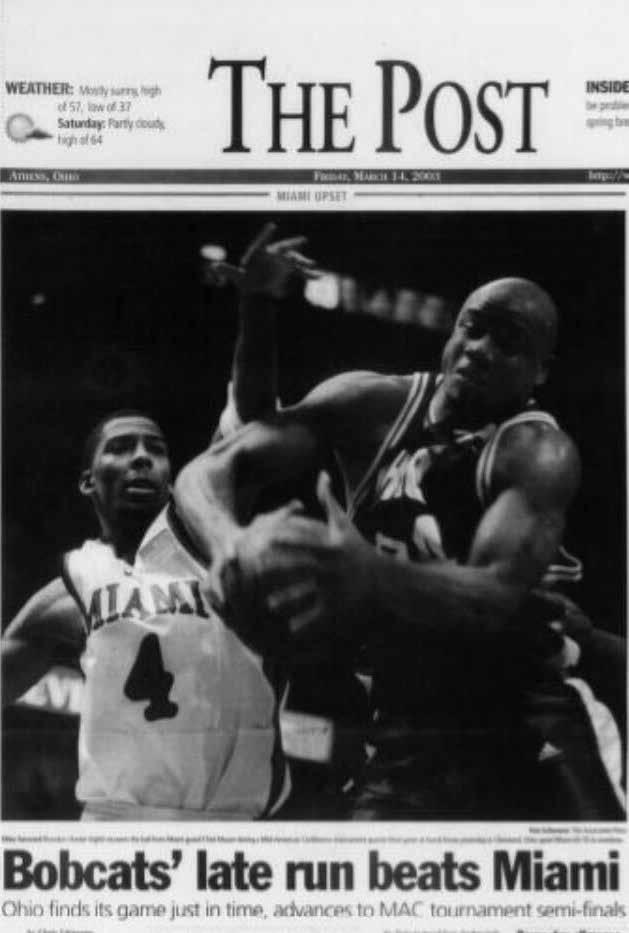
On Tuesday, Hunter tragically passed away at the age of 43.
In a social media post, current men’s basketball Head Coach Jeff Boals said Hunter was “one of the best to ever put on the green and white.”
In memory of Hunter, we’ve compiled some of his story-worthy feats from his time at Ohio:
In 2001, Hunter was named the best athlete of the season across all sports coming up just short of Mid-American Conference player of the year. (June 1, 2001)
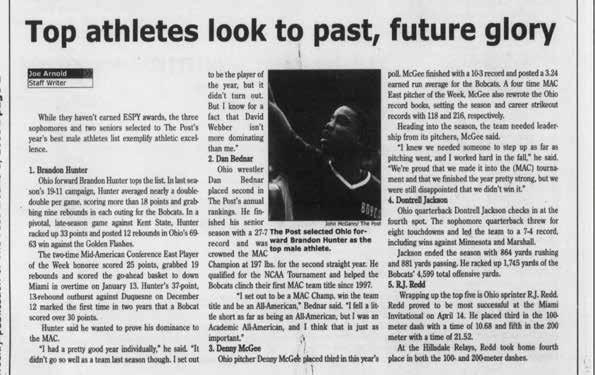
@ROBERT_KEEGAN
BK272121@OHIO.EDUOne of Hunter's defining moments was scoring a game-tying basket in the MAC tournament against rival Miami in order to keep the Bobcat season alive. (March 14, 2003)
As an emerging player, Hunter made strides on the court when he became the team leader in rebounds and in points. (Feb. 1, 2001)


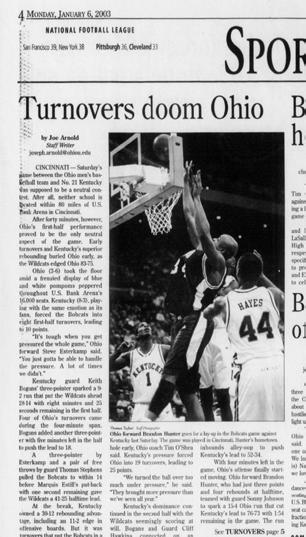
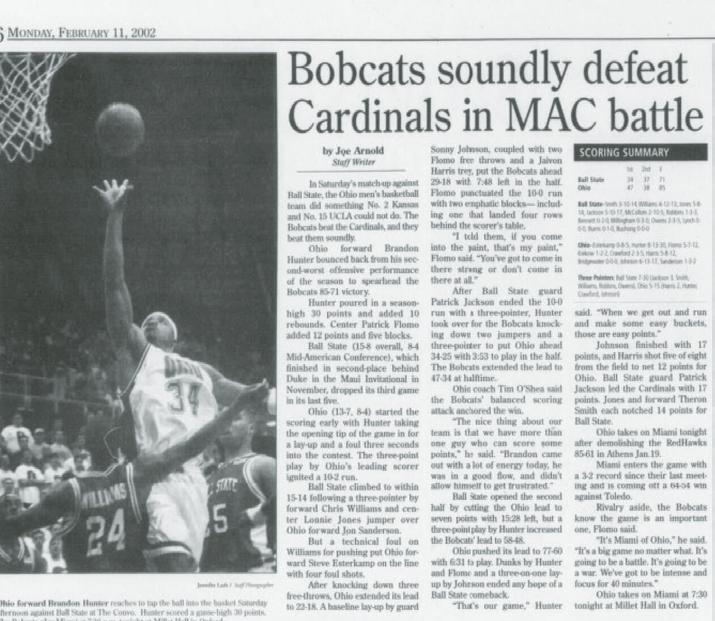
Hunter was a dominant player in MAC play throughout his four-year career, in the 2002-03 season Hunter led all of the NCAA in rebounds per game (Feb. 11, 2002).
(Left) After his impressive collegiate career, Hunter was a second-round pick in the 2003 NBA draft and he landed with the Boston Celtics. (September 2003)
(Right) Hunter was born in Cincinnati where he attended Withrow High School. Throughout his time at Ohio, Hunter stayed grounded in his Cincinnati roots. (Jan. 6, 2003)
Since I began my first year at Ohio University, I was encouraged to live out my college years to the fullest, join every extracurricular possible, take any class that would get me ahead and, most of all, study abroad anywhere I could.
I spent the fall semester of my junior year in Washington, D.C. as a part of the Scripps in D.C. program. Immediately after, I spent my winter break studying in Seville, Spain. Programs such as those may not be for everyone, but despite some hardships, I am truly grateful for the opportunities I experienced.
My Washington trip was my professional experience and Spain was my personal trip. Professionally, I chose to study in Washington to set my resume apart and experience what a potential job in the journalism field would look like. I also wanted to know what it would be like to live in Washington, as I had dreamt of living in a big city since I was little.
My trip to Spain was my soul trip. I knew I would be doing work while I was away, but I was most looking forward to the excursions and cultural opportunities that would be offered. I had never been out of the country before, so I knew I would grow in some way during that trip. I also wanted to learn more about the Spanish language, but I didn’t feel comfortable in my abilities to do a program that required fluency.
Unlike myself, student Corbin Williams knew he wanted to study abroad in Germany because he was fluent in the language. A junior studying sports management, Williams decided to participate in a global consulting program offered by OU in Bayreuth, Germany, during the summer of 2022.
He stayed in Germany for his entire sophomore year and enrolled in the dual-degree program at the local university. After he graduates this year, Williams will have one degree from OU and one degree from the University of Bayreuth. While Williams may not have experienced as much culture shock as others in his cohort, he said living in Germany was still an adjustment.
“I speak German, but the system of how they do things bureaucratically is completely unfamiliar to me,” Williams said. “So, navigating that process before I left was a little bit tricky.”
For the first few weeks of his trip, Williams worked as a student consultant to Adidas as part of the program. He and other students conducted research and pitched concepts to the brand’s executives. He said the biggest thing he walked away with was the ability to collaborate with people who are culturally different from him.
One problem I personally experienced was feeling isolated from my friends on campus, especially while I was in Washington. I was away for an entire semester, and my biggest fear was knowing that life was moving on without me in Athens. It was my choice to study abroad, yet I felt myself questioning that choice often.
The National Institute of Health defines the fear of missing out, or FOMO, as the “pervasive apprehension that others might be having rewarding experiences from which one is absent.” It is associated with a range of negative symptoms, such as lack of sleep, anxiety and a lack of emotional control. Many could say they experience this fear by not going abroad or taking other professional opportunities.
If I have to choose between staying in my room at night to review some information for a test or go out to dinner and see dancing in the plaza, I’m going to see dancing in the plaza.
I was scared that prioritizing my career and travel would cause me to miss out on my college life, something I knew I would never get back.
After I finished my classes through OU, I started an internship in the press office of U.S. Senator Kirsten Gillibrand from New York. It was truly an experience that changed my life forever, and I do not regret taking it on.
However, I did feel isolated many times during my stay in Washington. I worked different hours than the other people in my cohort and frequently worked from home because of the COVID-19 pandemic. Being at home alone often made me feel even more exhausted and anxious about being away.

For my Washington trip, I took classes Monday through
Friday for four weeks from 9 a.m. to 5 p.m. My cohort would meet at the National Press Club, where we would sip coffee and listen to industry professionals and OU alumni talk about their experiences.
I was so grateful to have had close conversations with so many journalism greats, but the classes were exhausting. At the end of the day, my cohort and I would take the metro home and crash into bed. For a while, I did not have a healthy balance.
For Williams, he said there was a proper balance between classwork and social life. However, he said the class structure did take some time to adjust to.
“In Germany, it’s normal to take 17 classes at a time and have them a few times a week or only once a week or once every two weeks,” Williams said. “It’s completely different.”
Haley Janoski, a 2023 graduate with a degree in communication studies, also used her study abroad experience as a way to grow both academically and personally.
In the summer of 2022, Janoski traveled to Toledo, Spain, to study the Spanish language and culture. She lived with a host family in Toledo while also taking three classes at the University of Castilla-La Mancha. Janoski was also able to travel on the weekends through planned trips and see more of the country, she said.
She said the program challenged her academically, but she still had the time and energy to explore the city and schoolwork.
“If I have to choose between staying in my room at night to review some information for a test or go out to dinner and see dancing in the plaza, I’m going to go see dancing in the plaza,” Janoski said. “That’s more important to me.”
For fellow student Caroline Rhude, the balance did not come so easily on one particular trip.
Rhude, a senior studying Spanish and social work, has studied abroad three times during college. She has traveled to Florence, Italy, as well as Toledo and Seville, Spain.
Rhude said she struggled with a healthy social and school-life balance on her trip to Toledo, as she was focused on school and studying more than traveling. Despite that, she said the pressure was not from professors or outside influences, but from herself.
“I felt the pressure only because I don’t think I understood what that study abroad was at the time,” Rhude said.
After her trip to Toledo, Rhude said she was able to learn better management skills during her future trips.
All of Rhude’s study abroad trips greatly differed from each other. She said she wanted to study abroad but did not feel comfortable yet with her Spanish language skills. So, she
Study abroad programs may not be for everyone, but despite some hardships, I am truly grateful for the opportunities I experienced.
HANNAH CAMPBELL PROJECTS EDITOR- Haley Janoski, 2023 graduate and former participant of the study abroad trip to Toledo, Spain
decided to travel to Florence which did not require knowledge of the language.
Her trip to Florence lasted for two weeks, and her classes were more excursion-based than traditional courses.
After traveling to Toledo, Rhude said she wanted to study abroad again in college. She was able to find the screenwriting and documentary storytelling trip to Seville which is through Scripps College.
It was during her trip to Seville that she learned how to better manage the social and schoolwork aspect of a study abroad program, she said.
Preparation is key
Study abroad programs through OU have different preparation requirements. Some require students to take multiple courses before leaving, others do not have any preparation at all.

Prior to leaving for Washington, D.C., my cohort and I had a few meetings with one of our program advisers to discuss internship applications and our living situation. However, we did not need a formal class because we were only traveling to another state.
Before leaving for Spain, our program director met with us multiple times over the course of the semester to discuss our final projects and other aspects of Spain we should know about.
While she enjoyed all of her study abroad trips, Rhude wished that one of her program directors would have educated her group more on the cultural and appropriate behaviors that were expected in the countries she traveled to.
“I’m very vocal about the importance of learning about another country’s culture (and) language or at least just the bare minimum of ‘What should you do? What shouldn’t you do?’” she said.

Student Claire Payuays also traveled to Toledo, Spain, this past summer. Studying political science pre-law and geography environmental pre-law, Payuays chose to go on the Toledo trip to fulfill her Spanish minor.
“I thought that it would be difficult for me to really grasp the language well if I didn’t immerse myself in the language more,” Payuays said.
Payuays, as well as Rhude and Janoski, took a preparation course taught by the Toledo program’s director. In the course, they all discussed cultural rules, safety guidelines and other important information before leaving.
Rhude emphasized that she was grateful for all of her study abroad experience. She said her biggest advice to students who are interested in studying abroad is to educate themselves on the country they’re traveling to and its culture.
“When you do things that are accommodating to other people, they take note of that,” Rhude said.
As much as I think I struggled while studying abroad, I know I grew immensely from it. The biggest difference I felt after I returned was my confidence. Both professionally from Washington and personally from Seville, I had a different perception of myself than I had ever had.
In Washington, I learned to trust my abilities and know that I can think quickly on my feet. In Seville, I learned that I’m carefree when I know I can be, and I’m always down for an adventure. These are things that I had never tested before and probably never would have if I didn’t study abroad.
Janoski said her study abroad experience was one of her favorite experiences ever, and the Toledo trip was “the perfect amount of challenging and comfort.” Her biggest takeaway was learning how to effectively advocate for herself, as she had certain dietary restrictions that she had to communicate during the trip.
Her biggest piece of advice to students looking to study abroad is to not be afraid of the unknown.
“When you’re there, just know that you’re going to have to get comfortable with being uncomfortable,” Janoski said.
As for me, my biggest piece of advice to anyone looking to travel abroad in college is to not let the experience get away from you. Live in the moment, because soon you will be back in Athens.
Jointly presented by The Athens County Humane Society & Friends of the Shelter Dogs



SATURDAY SEPT. 23RD 10am-3pm
ATHENS COUNTY FAIRGROUNDS at the ADOPTABLE PETS � KITTEN RACE
Animal Education � Charity Cruise-In
LIVE ENTERTAINMENT
Kids Activities � Caricatures
Vendors & Food Trucks and more FREE ADMISSION!
Sign up for the Shelter Dog Strut 5k Run/Walk

Run begins at 9:30. Registration opens at 9
The course will take you on a rolling tour of the fairgrounds, Well-Behaved dogs are welcome to run! SIGN UP TODAY























fun, but some promote excessive buying of trendy products and result in overconsumption.

Any product can become trendy: toys, food, beauty products, clothes, decorations and more; the list goes on. The most environmentally devastating trend is clothing hauls, but more specifically, SHEIN hauls. SHEIN is the most popular fast-fashion brand because of its extremely low prices and clothes that appeal to fashion trends. Consumers can buy 10 pieces of clothing from SHEIN for the price of one shirt at competing retailers like ZARA or Urban Outfitters.
There are thousands of videos under the search “SHEIN haul.” These videos reinforce buying clothes from SHEIN as trendy and fun without acknowledging the low quality of the clothes and unnecessary overconsumption. Reusable water bottles have also fallen victim to overconsumption, the latest being the Stanley Cup. While this trend may seem positive for encouraging reusable bottles, many users are collecting the cups in different colors or merely buying them because of the buzz on TikTok. Buying a water bottle just to replace it with a newer, trendier one defeats the purpose of owning a reusable water bottle.
up, data from Mintel suggests “Gen Z out-consumes older generations when it comes to fashion.” Gen Z is willing to spend lots of money on clothes to express their authenticity or conformity, yet another reason why they are likely to turn to fast fashion.
Trends and influencers are not the only attributes for excessive buying, as the app itself influences which videos users see. The TikTok algorithm shows users videos related to the ones they have already interacted with. The algorithm goes beyond monitoring likes, comments and shares by also tracking how long users watch a particular video. So, if a user just watches a video promoting a certain product, the algorithm will send similar videos to the user’s feed. The repetition of seeing the same or similar products several times influences users to buy the product. This is amplified when the product is tastefully paired with a popular influencer or video with a high like count.
Right now, no social media is more popular than TikTok. In March there were 150 million American users on the app, and over 60% of these users are Gen Z, or people born between 1996 and 2012. The app tailors toward users’ interests, showing users videos they are likely to enjoy. Many of the videos on the app follow trends from viral videos and popular influencers, but TikTok trends follow a rapid cycling in and out of what is trending. Many of these trends are all in good
TikTok created a new era of content producers, a.k.a. influencers. The job of an influencer is simple: influence. Similar to YouTubers, TikTok influencers produce content that appeals to their followers, and in exchange, their followers promote their content and gain them more followers.
Naturally, influencers sport the latest fashion and beauty products, so while it may not be intentional, the clothes they wear and the products they use entice their followers to buy similar merchandise. The difference between influencers and their followers is that influencers can afford to buy new, trendy products constantly, whereas their followers cannot. However, this has not stopped Gen-Z from trying to keep
What do you get when you combine a highly personalized algorithm, influencers touting products they enjoy and millions of people participating in trends? A foolproof marketing strategy. People use TikTok to enjoy original content and interact with videos suited to their interests, so users are inclined to purchase products they see on TikTok because they don’t perceive it as advertising. However, these interests change daily because the content presented to users changes daily. If you are Gen Z and a TikTok user, the next time you see a product you want, ask yourself what is influencing you to like it before you click “buy.”
Taylor Henninger is a junior studying journalism at Ohio University. Please note that the views and opinions of the columnist do not reflect those of The Post. Do you agree? Tell Taylor by emailing her at th873120@ohio.edu.

1-7 to bring awareness to this harmful form of censorship that affects our nation as a whole.
Now more than ever, education is being censored. Topics like racism and sexism as well as LGBTQIA+ themes being put to a halt in certain places are disregarding all students’ First Amendment rights. Florida laws like the Stop WOKE Act and the “Don’t Say Gay” bill don’t directly prohibit any titles from being incorporated into the curriculum, but they freely open the opportunity for books to be challenged and removed from school libraries and lesson plans. Evidently, many have done so as Pen America named Florida as having the second-highest number of banned books between July and December of 2022 at 357 books.
The American Library Association began observing Banned Books Week in 1982. According to its website, it “celebrates the freedom to read and spotlights current and historical attempts to censor books in libraries and schools.” Teachers, authors, students, librarians and supporters of the First Amendment can all come together this Oct.
In a similar, but not as severe situation is Ohio. There have been 79 titles challenged in total, but House Bills 322 and 327 that prohibit teachings of “divisive concepts” being passed could increase that number quickly. The bills haven’t been dismissed but have been in the House committee since 2021. With the growing popularity and turmoil of such censorship, Ohio may follow the trend. Bookshop.org, a popular online book-
store, has an entry titled, “We Don’t Ban Books Over Here” in which readers can purchase books that are typically challenged or banned in some schools or libraries. It includes works such as “Lord of the Flies,” “The Hate U Give” and “The 1619 Project.” One of the more ironic ones found on this list, which has been read by a large number of students who attended public high schools, is “Fahrenheit 451.” While its significance went over my head as a 15-year-old, it is certainly one of the most crucial books for readers today. Banning a book about banning books is a terrifying level of censorship that is inexcusable.
“The Kite Runner” has to be one of the most disheartening to see banned in certain counties in Florida. While it is completely available online, it’s heartbreaking that these students will never be guided through such a story by a passionate teacher who isn’t scared that their job is on the line for doing so. This book has no sexually explicit content or harmful themes; it is a story of a fatherand-son relationship amid a rising Taliban presence in Kabul, Afghanistan.
With that, the theme for this year’s Banned Books Week is “Let freedom read.”
Reading different perspectives and stories is one of our most rewarding freedoms, and removing that right from people is a disgrace to the developing minds of our country. The ALA reported that of the 2,571 titles flagged for censorship, “most were by or about LGBTQIA+ persons and Black, Indigenous, and people of color.” As a student and a human, these themes and perspectives that I don’t experience are crucial to understand so that I can better interact with the world around me.
Banning books is a direct and unfortunately common threat to the First Amendment. As “Banned Book Week” approaches, I encourage you to discover a book that has been banned or challenged. I’m almost certain that you will find a book that is not only enjoyable, but also worthy of belonging on the shelves of public libraries and on the syllabi of language arts classes without threats.

Layne Rey is a sophomore studying journalism at Ohio University. Please note that the views and opinions of the columnist do not reflect those of The Post. What are your thoughts? Let Layne know by tweeting her @ laynerey12.

In a national news environment that has too frequently presented Athens as a collage of Appalachian stereotypes, a different perspective has emerged this week from New York Magazine. “The Rutters of Athens County” is one of the best national representations of Athens County we have seen in reporting. Despite some imperfections within the article we wish had been remedied, it is a positive example of how to report on Appalachia and a spot of hope for the future of national reporting on our region.
The article dives into the term “Rutter,” the consolidation of Athens’ elementary schools and the economic divides within the county. The piece paints a picture of the derogatory term “Rutter,” writing about how it is thrown about the halls of the Athens school system and used to describe people and actions reminiscent of the Ewells of “To Kill a Mockingbird,” and its decline in use following the reorganization of the elementary schools.
The reporter, Dan Xi Huang, did a lot of things right. Huang went to Athens on multiple occasions and describes sitting around local dining room tables and speaking with officials, parents and kids. Huang is from Ohio himself, and remarkably this is the first article he has published with New York Magazine. His familiarity with the area is evident, although anyone dedicated to reporting and
Editor-in-Chief | Katie Millard
Managing Editor | Emma Erion
Digital Director | Anastasia Carter
Equity Director | Alesha Davis
EDITORIAL
News Editor | Madalyn Blair
Asst. News Editor | Donovan Hunt
Culture Editor | Alyssa Cruz
Asst. Culture Editor | Abby Jenkins
Sports Editor | Bobby Gorbett
Sports Editor | Robert Keegan III
Opinion Editor | Tate Raub
Asst. Opinion Editor | Meg Diehl
The Beat Editor | Grace Brezine
Asst. The Beat Editor | Grace Koennecke
Projects Editor | Hannah Campbell
Investigative Editor | Alex Imwalle
Copy Chief | Addie Hedges
Slot Editors | Arielle Lyons, Ashley Pomplass, Aya Cathey, Tre Spencer
ART
Art Director | Abbie Kinney
Asst. Art Director | Emma McAdams
Director of Photography | Alaina Dackermann
Photo Editor | Zoe Cranfill
DIGITAL
Director of Web Development | Tavier Leslie
understanding could have written this piece regardless of their hometown.
Unlike many other national pieces, it does not hyperfocus on coal, tragedy or supposed disparity. It addresses income inequality as a fact rather than as poverty porn or as some inescapable burden weighing on local families and gives multiple perspectives on the situation in an effective way.
The reporter also does the necessary job of acknowledging that Rutter is a family name, and does so well. Huang interviewed Tammy Hogsett – Tammy Rutter prior to her marriage – about her childhood, balancing the complications of witnessing the name used as a slur at school with the pride her mother, Bonnie Rutter, held in all that she did.
Bonnie Rutter is characterized as “beautiful and intelligent and compassionate,” a fantastically appropriate choice when discussing the family. This portion of the story is very human and written effectively and compassionately, and we are grateful the reporter had enough dedication to seek out the family and round out the Rutter name.
Among the good, however, there were a few things within the article that were confusing or lacking. It mentions “visiting the county zoo,” which does not exist, easily verified with a quick Google search. The article also did not mention that Athens High
Volume 114, Issue 4
ONLINE
School’s football field, famously renamed at the end of 2019 to honor Joe Burrow, is officially “R. Basil Rutter Field at Joe Burrow Stadium.”
According to the obituary for R. Basil Rutter’s wife, Claudine Rutter, Claudine and Basil Rutter donated the money to build the R. Basil Rutter football field at Athens High School in 1968. The pair owned and operated Steppes Beauticians for over 50 years, and also played a significant role in rebuilding the field after it was hit by a 2010 tornado. Given that the article focuses on the cross-section of the Rutter name and the local school system, it is quite surprising such a relevant piece of information was left out.
The article also paints local superintendent Tom Gibbs as the hero of Athens County. While it is refreshing to see someone other than Joe Burrow receive that title on a national scale, Gibb’s lack of humility on the topic leaves much to be desired. Gibbs shoulders much personal pride as if he has personally ended disparity in Athens.
The article allows him this vanity, particularly with a photo looking up at him sitting at his desk, quite literally above the rest of the article and the others featured. This is more on Gibbs than Huang, but Gibbs’ “appalled” first perspective of the school system when he moved here and need to “fix” the city brings the stigmatization of Appala-
thepostathens.com
thepostathens
@ThePost INSTAGRAM
@thepostathens
10 a.m. to 3 p.m.
Monday – Friday
Closed Saturday and Sunday
Baker University Center, Room 325
chia from outsiders to the piece that Huang seemingly worked hard to avoid.
These things are small because it is easy to be nitpicky when an article does well. Huang’s dedication and time to this story allowed us to comment on the smaller things because his larger portrayal of the area was respectful. His Ohioan status likely helps with the refreshing lack of apparent parachute journalism in the narrative, but a reporter does not have to be from Ohio to give Southeast Ohio the dedication and attention it deserves.
It is possible to speak about economic class in Athens in a non-offensive way on a national scale. It is possible to report thoroughly and appropriately on Athens as a non-local. Huang’s article proves respectful national coverage is possible. We say it is necessary. While there are smaller changes that could have improved the piece, we applaud respectful reporting when we see it, and we encourage other national outlets to treat Athens’ stories with the same time, respect and care.
Editorials represent the majority opinion of The Post’s executive editors: Editor-in-Chief Katie Millard, Managing Editor Emma Erion, Digital Director Anastasia Carter and Equity Director Alesha Davis. Post editorials are independent of the publication’s news coverage.
Have you ever find something in The Post thought-provoking, questionable or even infuriating? Let us know! We are always interested in hearing about the way our readers respond to our content.
Letters should be fewer than 500 words. All letters must be signed by at least one individual; anonymous letters will not be accepted. The Post does not accept letters soliciting donations or news releases. Please include your year and major if you are a student. The Post reserves the right to reject submissions or edit submissions for clarity, vulgarity and Associated Press style.
The Post is an editorially independent media outlet run by Ohio University students. We distribute the paper free of charge in Athens, Ohio, when classes are in session. Editorial page material represents the opinions of the editors, columnists and letter writers. Opinions expressed are independent of Ohio University and our printer.
IN PERSON
Baker Center, Room 325
ONLINE thepostathens.com/letters BY EMAIL letters@thepostathens.com
Audience Engagement Editor | Logan Jefferies
Asst. Audience Engagement Editor | Jenna Skidmore
Director of Multimedia | Cole Patterson
Asst. Director of Multimedia | Kendall Timms
BUSINESS
Media Sales | Gia Sammons, Molly Wilson
Director of Student Media | Andrea Lewis
1 Park Place Athens, OH 45701
(740) 593-4010
The Post will not print advertising that violates local, state or federal laws. The Post will not run advertisements that violate the Fair Housing Act, or the Equal Employment Opportunity Commission policies. The Post reserves the right to reject advertising deemed to adversely affect the integrity and credibility of the publication or be in conflict with the educational mission of the university or community it serves. The Post retains the right, at its discretion, to approve or reject an advertisement that negatively affects the relationship with our readers or that promotes content, services, or activities that violate our advertising policy.
If an error occurs, and an advertisement is published not as ordered, please notify The Post by the end of the business day following publication, a corrected advertisement will run without charge in the next print edition. Cancellation requests for advertising must be received and acknowledged by staff no later than 2:00 pm on Wednesday for the Thursday print edition. Refunds will not be given for ads that have been printed. These advertising policy rules can be changed at any time without prior notification.
K-pop music has become a dominant genre in mainstream music thanks to the help of acts such as BTS and BLACKPINK, allowing for the music industry to expand its range of diverse artists and perspectives. Yet, a lot of music lovers don’t truly know its origins, nor do they have a clear understanding of how the genre will continue to impact the future of music. Look no further; here’s a history of K-pop music.
First, K-pop, or Korean pop, music originates from South Korea, drawing influences from other genres such as pop, experimental, rock, hip-hop, R&B, electronic and dance. Songs are inspired by traditional Korean mu-

sic as well, usually containing Korean lyrics mixed with English lyrics throughout.
The genre became relevant in the 1950s when Korean-born pop trio The Kim Sisters broke through to the mainstream. They performed soulful renditions of American pop songs of the time, also gaining more of a following during the Korean War. The trio also appeared on “The Ed Sullivan Show” a total of 22 times and were the first Korean singers to have a song appear on the Billboard chart, making them the first Korean group to achieve success in the U.S.
Laying the groundwork for future artists, more K-pop artists began to emerge in the 1970s, and this time period was when many artists began utilizing political activism in their music. These themes came to fruition
through Kim Min-Ki, a folk-rock singer and composer. In 1970, he wrote “Morning Dew,” a song about the pro-democracy movement during major U.S. events such as the Vietnam War, allowing Korean music to be taken more seriously by the public.
Twenty years later, the first inklings of K-pop groups forming came with the rise of Seo Taiji and Boys. With a massive following, the group sparked news with their hip-hop choreography, and many critics consider them to be the first major K-pop group in music history. Once groups like these were discovered, the 1990s became a place for more Korean acts to thrive.
Acts such as H.O.T., SECHSKIES and S.E.S., made up of trained K-pop stars and dancers, were also considered some of the first K-pop
groups. H.O.T. released their song “CANDY” in 1997, becoming a massive hit in North and South Korea. This group became known as the “First Generation” in K-pop, spanning from the 1990s into the early 2000s.
The “Second Generation” followed, lasting from the early 2000s into the 2010s. One group, g.o.d., or Groove Over Dose, debuted in 1999, starting the transition into the next generation of K-pop stars. Following the same blueprint as their predecessors, g.o.d. became one of the most popular boy bands of the early 2000s in South Korea. Next came pop duo TVXQ!, who released its first hits in 2003. Other groups such as SUPER JUNIOR and BIGBANG arrived in 2005 and 2006, while FTISLAND made its mark in K-pop in 2007.
Now, we’re currently in the “Third Generation,” which began in the early to mid-2010s. This generation is arguably K-pop’s most successful, as many groups have integrated themselves into the mainstream. Groups such as BTS, EXO, SEVENTEEN and BLACKPINK are the current bestsellers in the genre, with many headlining some of the world’s biggest music festivals such as Coachella, Lollapalooza and the Global Citizen Festival.
The reason why all these groups have been so successful in other countries is because of their social media presence, which the two generations before them did not take into account. Ever since the creation of sites such as TikTok and Instagram, K-pop has been able to reach users all around the world, aiding them with tasks such as launching and advertising content, streaming and revenue sales of albums and merchandise.
Meanwhile, K-pop has also dominated the world of streaming, with BTS, BLACKPINK, TWICE and Stray Kids surpassing over five billion streams on Spotify in the last few years, a feat that many American artists have not been able to achieve.
So, if you’re looking to expand your musical palette, K-pop music is the next genre to look into, as it’s already becoming one of the world’s most popular art forms. With fun, inspiring and influential songs and artists, this genre has created an inclusive space for all listeners to sing, dance or even cry to, making it worth one’s time to explore. @GRACE_KOE
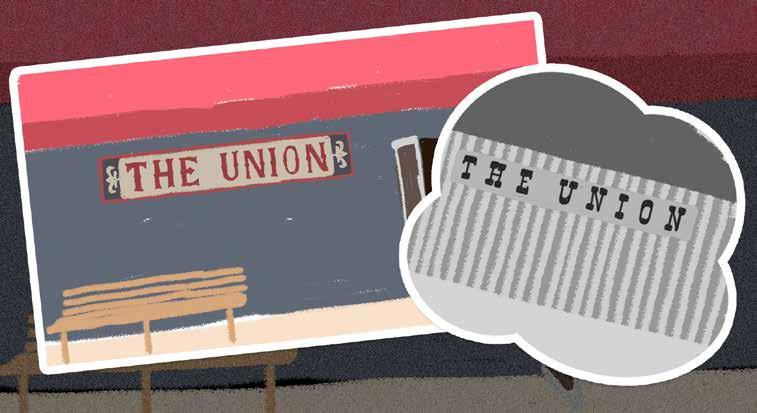
Wedged between a Starbucks and Jackie O’s Public House on West Union Street lies a gem of Athens culture. The Union is an 18+ bar offering live music, annual events and, like any good bar, alcohol for those who are of age. While many Ohio University students have frequented The Union, possibly for a trivia night or the Rocky Horror Picture Show in October, many attendees are unaware of the rich history behind the establishment.
The Union began its life as The Elks Hotel, which contained approximately 20 rooms for families to stay in during the Great Depression. It was located at a prime spot near the train station that used to stand at the foot of the West Union Hill, which along with its 10cent hot dogs, made it a natural place to stop. The hotel was open during prohibition, and some members of the Union’s inner circle like to believe that their rebellious streak began by selling illegal alcohol during that time.
In the 1940s, the hotel began to cater more to college students after World War II ended, beginning the bar’s path to becoming the perfect blend between the college and the town that it is today. This new shift in demographic allowed the bar, which was located in the basement, to become more popular, and the hotel was eventually converted into a two-story bar and an instant hang-out spot for beatniks, hippies and anyone else away from the mainstream crowd.
The expansion of the music scene in Athens is largely credited to The Union. Throughout the ‘80s and ‘90s, the Union hosted the eccentric crowd who needed a sanctuary where they could be themselves and listen to the best new music around. The bar would feature grunge, alternative, rock and indie bands, along with stand-up comedy and the occasional spoken-word/hiphop act.
One of the greatest staples of the bar was Blackout Fest, a three-day bender with bands performing back to back, sometimes
even on top of the bar counter. Musicians would see how intoxicated they could become while still being able to play, and the crowd was reduced to a sea of sweat, spilled beer and disconnected bodies throwing themselves around in a celebration of creation and community. What started as a silly party soon became a huge event, and making it into the lineup of Blackout Fest became an aspiration for many local musicians.
Then, on Nov. 16, 2014, The Union was suddenly a pile of rubble and burnt-up debris. A raging fire took down the entire building, rendering it entirely uninhabitable. For 18 months, employees and regulars mourned the loss of their beloved home. They wept over the destruction of their community space and for the physical evidence of friendships and self-discovery that had become nothing more than smoke and ash. Casa Nueva hosted a celebration of life for the bar, where people were able to at least come together, even if not in their preferred place. Casa, along with many other bars in
town, showed support and tied customers over until The Union reopened almost a year and a half later.
After a long process of reconstruction, the Union reopened in 2016 with a massive concert and gathering of people to celebrate the return of their beloved bar. While the layout had certainly changed, The Union was back up and running and remained a place that fostered friendships and creativity where you were taught to accept the dysfunctionality of life and take it in stride.
Today, The Union is still one of the most important facets of Athens culture. It put the town on the map over its many years of existence and made it a major hub for music, and it still hosts events that encourage everyone and anyone to experience the magic of the place. For a more in-depth history of the iconic spot, watch "Last Call - The Union Documentary."
Same great vendors in a NEW space. Now located at the Athens Community Center. Parking Available at the Community center and the City Pool lot. If walking to the market, PLEASE use designated crosswalks to cross East State Street
Locally grown, raised and prepared food and beverage items. Plants, dairy, baked goods,seeds, and meats. PLUS locally made artistic goods.


“Bottoms” nails the classic sex comedies of the 2000s with a refreshing LGBTQIA+ focus. “Bottoms” is the sophomore feature of Canadian director Emma Seligman, who rose to prominence after the critical success of her debut masterpiece “Shiva Baby” in 2020. Fortunately, Seligman manages to avoid the dreaded sophomore slump with an over-the-top erotic sex comedy — already a critical success with strong box office numbers, according to Deadline.
The premise of the film starts relatively simple. Josie (Ayo Edebiri) and PJ (Rachel Sennott, who reunited with Seligman after starring in “Shiva Baby”) are two openly lesbian high schoolers who discuss their plans to lose their virginities to their crushes at the night’s carnival. After reuniting with their friend Hazel (Ruby Cruz) at the carnival, PJ and Josie attempt to win over their crushes, two Rockbridge Falls High School cheerleaders Isabel (Havana Rose Liu) and Brittany (Kaia Gerber).
After sparking the vengeance of the Rockbridge Falls High football team, Josie and PJ are forced to come up with a plan to escape from suspension. Thinking quickly on their feet, the two create the ultimate lie and, in turn, create a women’s fight club under the false premise of self-defense and female solidarity (thanks Hazel). Unbeknownst to the club’s participants, PJ and Josie’s true intentions are to win the love of their crushes and lose their virginities.
“Bottoms” is a film that was made with Generation Z in mind, and it is reflective of that in its development. The soundtrack sees a collaboration between Leo Birenberg’s long repertoire of film and television musical composition and the electropop, experimental pop and hyperpop sounds of Charli XCX. The infused sound pairs well with the film, and is coupled with needle-drops of “PAIN” by genderqueer artist King Princess and Avril Lavigne’s “Complicated” to emphasize the queer and young demographic the film caters to.
The unabashedly queer, feminist and referential co-written screenplay between Sennott and Silegman also reflects the Gen Z and millennial appeal the duo tapped into. Second-wave feminism, feminists who watch the television series “Entourage” and the assumed juxtaposition of Black Republicans are all satirized in quick jokes that may
go over some viewers’ heads. Meanwhile, the two leads are both called homophobic slurs on their lockers and “untalented gays” all in 10 minutes.
Jokes are also not afraid to catch you off guard in scenes of intense emotion, and both Sennott and Seligman walk the line of a tasteful offensive comedy most recently brought into light with fellow R-rated comedy “No Hard Feelings.” At times, however, some bits feel more shocking than humorous while others simply do not land. This is most evident with a minor subplot of the film, played mostly as a recurring gag that fizzles out as soon as it begins.
The queer nature of the film shines throughout the overtly vulgar “Bottoms.” Right off the bat, PJ and Josie openly discuss their failures in securing the love of their crushes because they are self-described “ugly lesbians.” The scene is crude, overtly sexual and establishes the presence of self-deprecating and awkward humor frequent in the film. Yet, it also establishes the raw chemistry between Sennott and Edebiri, who are longtime friends in real life.
Performance-wise, the two leads are portrayed by two of the newest faces of current Gen-Z culture and the film provides the duo with ample opportunities to flex their craft. Sennott’s brash yet comedic performance of the often deadpan PJ is reminiscent of her role in the indie horror darling “Bodies, Bodies, Bodies.”
Sennott is fully committed to the role, portraying the character’s journey of jealousy with perfection. While playing a more reserved role, Edebiri’s effortless timing of her subtle physical comedy brings life to an already sympathetic character. However, it is when Josie begins to blurt out one of her many spontaneous monologues that Edebiri’s true comedic efforts truly shine.
Outstanding supporting performances also come from the ensemble cast of fresh faces. Former NFL running back Marshawn Lynch plays the straightforward history teacher Mr. G with such ease that it feels like he was born for the role. His ease of stealing scenes is only rivaled by Miles Fowler, who plays the homoerotic and Jeff-obsessed jock Tim in such sadistically golden fashion. Kaia Gerber, who had a poorly received start at acting in the “American Horror Story” series, can shine as the dry, flirtatious Brittany while her frequent scene partner, Havana Rose Liu, brings depth to the love-stricken girlfriend Isabel.
While also leads and story progressors of their own, the performances of Hazel and Jeff are worth mentioning. Ruby Cruz gives nuance to the ill-fated victim of PJ’s intense jealousy and juggles her character’s unpredictability and sincerity with satisfaction. Despite his character not being as complex, recent “Red, White, & Royal Blue” breakout star Nicholas Galitzine elevates the airheaded jock Jeff from the confines of a one-note bore.
Despite its strong comedic standing, the film ultimately shines in its fight sequences — whether it is montages or a triumphant battle. Seligman’s directing of these initial scenes in the high school is intentional and direct. At times, the camera lingers on the closeness of the two characters fighting on screen, highlighting the sexual tension building between them. At other times, the scenes are full of rough hits and slow motion descents to the ground, showcasing the sheer brutality of the characters in a relatively unrough environment.
Anytime a character is hit, a punch is swung or a face is slapped, viewers can hear and witness the effects of each rough con-
nection. Blood is splattered, characters are bruised and swords are even (attempted to be) swung. “Bottoms” is as anarchistic as it is sarcastic, representative of its R rating.
Ultimately, the unabashedly queer nature of “Bottoms” shines throughout its 92-minute runtime. While not all characters work, they are unapologetically themselves. And almost every line of comedy is quick, witty and 10 steps ahead of the viewer even if it does not land.
“Bottoms” is an unafraid and brash comedy that brandishes its rough nature on its sleeves. It is an all-around treat for fans who unknowingly want a satirical-feminist-queer-fight film that is a tonal departure for Seligman, who miraculously avoided the sophomore slump.

Rating: 4 / 5
TB222023@OHIO.EDU
Bad bike
A theft at Ewing House was reported to OUPD. A report was filed for bike theft.
Truck troubles
A male allegedly breaking into a U-Haul truck in The Plains was reported to the Athens County Sheriff’s Office.
Upon arrival, deputies found that the individual had the proper paperwork proving that they had rented the trunk. A report was taken due to there being damage to the truck.
Exit here?
Destruction of property in Sargent Hall was reported to the Ohio University Police Department.
A report was taken for damage to an exit sign.
Bambi
Athens County Sheriff’s Office deputies responded to Long Run Road in Athens regarding an injured deer.
Blocked and reported
A call regarding an individual being harassed on social media was received by OUPD. A report was taken for telecommunications harassment.
Boy who cried wolf
Someone yelling for help on Lemaster Road in The Plains was reported to the Sheriff’s Office.
Deputies spoke with the suspect and no further action was necessary.
Missing digits
The theft of a cell phone in Athens Township was reported to the Athens County Sheriff’s Office.
A report was taken and as of the weekend, the incident remained under investigation.
Gatorade mishap
Disorderly conduct on College Green was reported to the Ohio University Police Department.
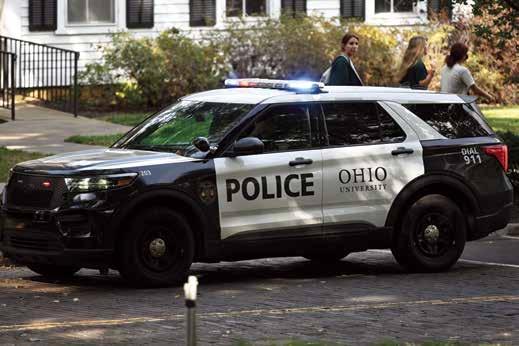
An individual was warned for throwing Gatorade on another person. The person then declined to pursue the matter criminally.
Scammy scam
A suspicious phone call was reported to the Sheriff’s Office. The individual was advised that the phone call was a scam and to block the phone number.
Cannabis crusade
An offense of possession of controlled substances was recorded at Lincoln Hall, according to OUPD.
OUPD collected marijuana for destruction.
K-9 Fumble
An injured dog on state Route 13 in Trimble was reported to Athens County Sheriff’s Office deputies.
The officers located the dog, which ran away from deputies, but appeared to be fine.
Property damage in Parking Lot 53 was reported to OUPD. A vehicle had been damaged from a tree branch falling on it.
Going golfing
A stolen golf cart from the area of Radford Road in Athens was reported to the Sheriff’s Office. As of the weekend, the case remains under investigation.
Fake face
An offense of possessing/displaying fictitious identification occurred at Jefferson Hall, according to OUPD. The contraband was collected for destruction.
Meow
A dispute over a cat on East State Street in Athens was reported to the Sheriff’s Office. Upon arrival, deputies were unable to determine ownership and the parties were separated.
Sibling rivalry
A dispute between siblings on Gun Club Road in New Marshfield was reported to the Athens County Sheriff’s Office.
Upon arrival, deputies spoke with both parties and deemed no physical violence had taken place.
After deputies left, one member of the dispute started making suicidal threats, so officers returned to the residence. Deputies then transferred the individual to the hospital for an evaluation.






